It seems obvious to most that there is no connection between the Arab Palestinian movement and the German Nazi Final Solution: the WWII genocide of the European Jews.
This belief is crucial to the prestige of the Arab Palestinian movement.
It is a false belief.
Here is an argument common in the ‘pro-Palestinian’ camp:
‘Pro-Palestinian’ argument: The Arab Palestinians should not be made to pay for the German Nazi Final Solution, the genocide of the European Jews known as the crime of the Shoa (or Holocaust), because the Arab Palestinian national movement was not responsible for that crime. Israeli Jews should therefore give the Arab Palestinians the disputed territories—which rightfully belong to them—for a Palestinian State.
Back in 1993, this argument became diplomatic reality with the official birth of the Oslo Peace Process, organized by the US bosses.
The Oslo process brought the Palestine Liberation Organization (PLO)—internationally recognized as the legitimate representative of the Arab Palestinians—into the Jewish State to govern the Arab Muslims in the disputed territories of Judea & Samaria (‘West Bank’) and Gaza, with a view, later, to carving these territories outright from the Jewish State for a PLO State.
I supported all that in 1993 because, back then, the two fundamental premises of the above argument both seemed obviously true to me (since everybody around me affirmed them):
the Arab Palestinian movement had no responsibility for the Shoa; and
the Zionist Jews unfairly took Arab Palestinian land.
Plus, Big Media and an endless parade of academics assured me that the PLO, a terrorist organization dedicated to the violent destruction of Israel, had transformed itself and now believed in negotiating peace in exchange for territory. I believed it. I thought we were having a Hollywood moment. And when they said this would settle the Middle Eastern disputes and bring peace to all, I believed that too.
I sound like an idiot. But in my defense, the ground was still trembling in 1993 from the Great Fall of the Soviet Union. It was The End of History, according to Francis Fukuyama. We would all live in free-market democracies forever and all humans would be at peace. By golly, I was only 23-years-old. And the thing happening on my TV was simply heart-stopping: on the White House lawn, PLO Chairman Yasser Arafat was reaching across US President Bill Clinton’s self-satisfied puckered smile to shake the hand of Israeli Prime Minister Yitzhak Rabin! I thought: done deal.
I think I cried.
Ten years later (for reasons that I will explain in a future article) I began investigating the history of the Arab-Israeli conflict and came across facts that completely shattered my confidence in the aformentioned two key premises, forcing a reassessment of how basic historical reality should be described.
My reassessment of the second premise I will not discuss here (but you may consult my views on that in this link).
In this piece what I’ll do is focus on the explosive fact that completely changed my mind concerning the first fundamental premise, which I had so confidently imagined simply had to be true: that the Arab Palestinian movement had played no role in the WWII Shoa. Because: Why in the world would the Arab Palestinian movement have anything to do with the Nazi slaughter of the European Jews?
Right?
Imagine my surprise… I now learned, to the contrary, that the very founder of the Arab Palestinian movement, Hajj Amin al Husseini, Grand Mufti of Jerusalem, had played the leading role in the German Nazi Final Solution.
What!? You read correctly.
The abbreviated story follows (books and articles with the relevant documentation can be found at the end of this piece).
The story, in short…
In the early 20th century, young Amin al Husseini was a prince hailing from the most important family in Jerusalem, very connected with the government of the Ottoman Empire, then lord of the Middle East. His grandfather, Mustafa, his father Sheikh Tahr al Husseini, and his brother Kamal had all occupied the office of Mufti of Jerusalem, and his cousin Musa Kasim Pasha was mayor of the same city.
At 19, young Amin was sent to Cairo to study Islamic philosophy but he didn’t finish and went instead to Mecca and Medina, which earned him the title of pilgrim or hajj. After this, Hajj Amin became an officer in the Ottoman Army, which fought on the side of the German and Austro-Hungarian Empires in a European war of conquest that we remember as World War I (1914-1918). When that formidable German-Muslim alliance was defeated, the Ottomans lost their Middle Eastern possessions, which now came under British and French control.
At the League of Nations (precursor to the United Nations), the British Empire successfully negotiated for receiving control, as an administrative ‘mandate,’ a formerly Ottoman territory where Jews—in defiance of the Roman and jihadi Muslim genocides they had suffered—had always continued to live, and which included the ancestral homeland of the Jewish people and their holy city of Jerusalem.
The British chose to give this territory the name ‘Palestine’ (a name that neither the Ottomans nor the local inhabitants used). To obtain the Palestine Mandate, the British Empire formally promised to the League that they would help create, in this territory, a Jewish National Home where the Jewish people could be safe from the ongoing European persecutions.
Husseini was not happy about that, and he expressed his emotion by launching the Arab Palestinian movement with massive terrorist attacks against Jewish civilians—Jews who’d already been living there from Ottoman times and long before: the Al Nebi Musa massacre. Husseini timed this attack carefully to coincide with the League’s 1920 San Remo Conference, where the British Mandate would be created, in hopes of sabotaging that decision by making it clear that no Jews would be peacefully received.
The Mandate was created anyway. But not—mind you—because the British bosses really disagreed with Husseini. The British protected Husseini from justice and soon after, in 1921, made him the Grand Mufti of Jerusalem, endowing that office with greatly expanded powers from what the Mufti (sans ‘Grand’) of Jerusalem had enjoyed under the Ottomans. In the years to follow, leveraging his position as Grand Mufti of Jerusalem, and with the help of the British, Husseini would organize other massive terrorist attacks—pogroms—against civilian Jews in British Mandate Palestine: in 1921, 1929, and 1936-39.
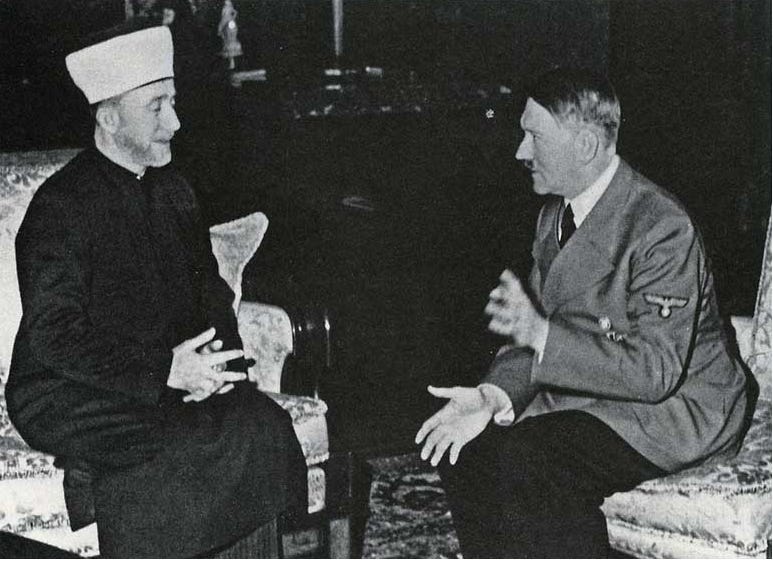
When World War II broke out, Husseini traveled to Baghdad, where he organized the destruction of the very ancient Baghdadi Jewish community in a pogrom called the Farhud. Then he was off to Rome and finally to Berlin. Everywhere he was received with full honors, almost as if he were a head of State. The German Nazis had all the dignitaries out to receive him, including Adolf Hitler himself, who sat down with Husseini immediately to seal important agreements with him, among which was their joint commitment to work together to exterminate the Jews living in British Mandate Palestine.
The Nazis were very excited about Husseini. They were building alliances with Arab Muslim bosses everywhere, and had already sent Husseini weapons for his fourth—and greatest—terrorist attack against the Jews of British Mandate Palestine (the so-called ‘Arab Revolt’ of 1936-39). The Nazis believed the now-very-famous Husseini might become, after the war, and with their help, the next Islamic Caliph.
Moreover, the Nazis admired Husseini’s track record as a mass murderer of Jews in British Mandate Palestine and Iraq. Right away the Nazis decided they could put Husseini profitably to work.
Hitler made Husseini a top Nazi official with his own budget and bureaucracy: Buro des Grossmufti. Husseini thus became important:
in Nazi propaganda directed at Muslims;
as recruiter and trainer of entire divisions for Heinrich Himmler’s SS made up of Bosnian and Albanian Muslims; and
as co-administrator—in partnership with Adolf Eichmann—of the industrialized death-camp system that murdered the European Jews.
(Don’t adjust your screen or rub your eyes. You read correctly: The Founding Father of the Arab Palestinian movement co-led, for the German Nazis, the extermination of the European Jews. Yes, yes: I am speaking of the Shoa or Holocaust.)
After the war, the British and French allowed Husseini to escape to Cairo where King Farouk and then Gamal Abdel Nasser protected him. Lots of German Nazi fugitives also arrived there and got protection too.
In 1947, the United Nations voted to partition what remained of British Mandate Palestine, and to create there a laughably minuscule Jewish State plus a second Arab Palestinian State (the first was Jordan). But Husseini’s Arab Higher Committee—‘representing’ the Arab Palestinians, and in solidary unity with the rest of the Arab bosses—rejected the partition plan. Husseini rejected, in other words, the Palestinian State that the United Nations offered him.
Husseini and other Arab bosses publicly explained that they weren’t interested in any kind of Arab Palestinian State. What they wanted was to destroy any possibility of a Jewish State, because a Jewish State of any size was completely intolerable to them. The Secretary General of the Arab League, Azzam Pasha, unashamed for the fact that the German Nazi Final Solution had only just recently concluded, and, speaking for all the Arab League bosses, publicly announced that the Arabs would together launch, against the new State of Israel,
“a war of extermination and momentous massacre which will be spoken of like the Tartar [Mongolian] massacre or the Crusader wars.”1
Or, he forgot to say, like the German Nazi Final Solution of his mentor, Hajj Amin al Husseini.
Husseini co-led the united Arab effort to exterminate the Jews who’d fled to the Middle East to create the State of Israel as a refuge from genocide. Several Arab States, plus the Arab Palestinians led by Husseini’s Arab Higher Committee, attacked the fledgling State of Israel.
The Arabs took no prisoners: any Israeli soldiers captured were slowly tortured to death (just like Jewish civilians were, recently, in the attacks of 7 October 2023), so it became general practice for Israeli soldiers to commit suicide by grenade if capture became imminent.2 This genocidal attempt of the Arab Muslims is now called the War of 1948 or the Israeli War of Independence—rather than ‘Holocaust 2.0’—because the Israeli Jews (amazingly) won.
Husseini and his cronies cynically baptized the Israeli victory the ‘Nakba’ (‘Catastrophe’), because for these guys it is a catastrophe when they cannot properly exterminate millions of Jews. Media and academia have cooperated with the ‘Nakba’ narrative, as if the Israeli Jews had worked to impede the formation of a Palestinian State, when what really happened is that the Israelis fought a defensive war against Husseini and other Arab leaders who, rather than accept the second Palestinian State that the UN offered, preferred to try and exterminate the Israeli Jews.
Following the alleged ‘Nakba,’ in the 1950s Husseini created the terrorist group Al Fatah, handpicking Yasser Arafat and Mahmoud Abbas to lead it and see it through to the final mission: to kill all the Jews in Israel. Husseini used fugitive German Nazis in Cairo to give the core group of Fatah founders some German-Nazi training.
In 1964 Egyptian dictator Gamal Abdel Nasser created the Palestine Liberation Organization (PLO) as a confederation of Palestinian terrorist groups, but soon Husseini’s Al Fatah found itself in a position to swallow the PLO, as historian Howard Sachar explains:
“... in February 1967 the PLO [Palestine Liberation Organization] leader [Ahmed Shukeiry] was wounded in an assassination attempt. For the while, as a result, the organization was at least partially immobilized by factional intrigues.
Not so a rival, and even more radical Palestinian group in Syria, the Fatah (Arab Liberation Movement), organized several years earlier by veterans of the Mufti’s [Hajj Amin al Husseini’s] former Arab Higher Committee.
... From the outset... the Fatah’s reputation depended largely upon the success of its Moslem traditionalist approach of jihad against Israel, and upon conventional infiltration methods.”3
The year after the assassination attempt on PLO boss Ahmed Shukeiry, Husseini’s Al Fatah took over the PLO with Husseini’s explicit blessing. As historians Barry Rubin and Wolfgang Schwanitz summarize from information they obtained digging in the archives of Lebanese intelligence,
“On December 29, 1968, at a meeting in the ex-grand mufti’s home near Beirut [Lebanon], al-Husaini anointed Arafat as his successor. The movement would be directed by these two sequential leaders and their similar philosophy and methods for an astounding eighty-three years, from al-Husaini’s becoming grand mufti in 1921 to Arafat’s death in 2004. In December 1968, the thirty-nine-year-old Arafat, leader of the Fatah guerrilla group, was about to take over a PLO hitherto dominated by the Nazi collaborator [Gamal] Abd an-Nasir. But Arafat’s success would be all the more secure if he received the seventy-one-year-old al-Husaini’s endorsement. Al-Husaini gave it after lecturing Arafat for several hours on how he should go about destroying Israel and replacing it with a Palestinian Arab state. Within a few weeks Arafat controlled the movement as thoroughly as al-Husaini had ever done.”4
The PLO essentially and thoroughly became Al Fatah, as Sachar explains:
“By [1970]…the splinterization of the guerilla ranks largely dictated the altered nature of their offensive against Israel. Nominally, most of them belonged to an umbrella coordinating federation, the Palestine Liberation Organization. Yet this prewar, Egyptian-dominated group had been seriously crippled … and its leader, Ahmed Shukeiry, had been forced into retirement. Since then, the PLO had experienced less a revival than a total reincarnation of membership and purpose under the leadership of Yasser Arafat. Consisting ostensibly of representatives of all guerilla organizations, the PLO in its resurrected form was almost entirely Fatah-dominated, and Arafat himself served as president of its executive. In this capacity he was invited to attend meetings of the Arab League, and won extensive subsidies from the oil-rich governments of Saudi Arabia, Kuwait, and the sheikhdoms of the Persian Gulf.”5
Though it now called all the shots, Al Fatah nevertheless kept the name: PLO. That’s why I always call it PLO/Fatah—because the PLO (what we now call the ‘Palestinian Authority’)—is really Al Fatah.
When this background is understood, history acquires a chilling description: US bosses brought into the Jewish State—the State created expressly to protect the Jews from Nazi genocides—the terrorist group created by Hajj Amin al Husseini, chief co-architect of the German Nazi genocide. And US bosses called this the Oslo ‘Peace’ Process!
Why total silence on Husseini?
The documents to establish all this were all in the University of Pennsylvania library, where I found them in 2003. And I had invested only two weeks of work. So the obvious question was: Why hadn’t anybody said anything to me about Husseini before?
My ignorance was dramatic. I was a freshly minted anthropology Ph.D. specializing in ethnic conflict and working at an ethnic-conflict think tank (at the University of Pennsylvania) focused on the Oslo Peace Process.
And the Shoa is the most famous genocide of all. Even before getting my Ph.D., I had read a lot about the Shoa.
Moroever, Husseini himself had been world famous still at the close of WWII, when various parliamentarians in the British House of Commons had angrily demanded to know why he wasn’t being tried in the Nuremberg War Crimes Tribunal for war crimes and crimes against humanity.6
And yet, before making it a personal mission to understand the history of the Arab-Israeli conflict, I had never come across Husseini.
Why not?
Some additional research answered that question. Right around 1968, which is when Al Fatah was taking over the PLO, all mention of Husseini ceased abruptly, and completely, in both media and academia. Because of this blackout, by the time US bosses organized the signature of the Oslo Accords in 1993-94, nobody remembered Husseini.
Western and Israeli citizenries did not understand, therefore, that US bosses were bringing a group created to finish Hitler’s job into the Jewish State.
What are the implications of all this?
One implication of this is that, if our meaning-making system—the Extended Fourth Estate, the institutions of media and academia—stop mentioning something; if they remove it entirely from the historical context they provide when explaining current events, then just a few years will suffice to erase it completely from the consciousness of the general public. That is a social-psychological phenomenon that is crucial to an understanding of the management of reality, and we discuss it here:
A second implication is this: we must establish—this is vital—whether the claim that PLO/Fatah abandoned its goal of destroying the Jewish State in genocide makes any sense.
One way to get your bearings on this question is to consider the birth of jihadi Iran, established in 1979 by Ayatollah Ruhollah Khomeini’s Islamic Revolution. That Iranian jihadi State, recall, promises to exterminate the Israeli Jews and proudly puts its money where its mouth is, as demonstrated on 7 October 2023 and subsequently (and previously).
Well guess what? It was just a few years before the first diplomatic stirrings that became the Oslo Process, that PLO/Fatah got busy creating the jihadi state of Iran. They put Ayatollah Khomeini in power in Iran and created the key Iranian institutions used to oppress ordinary Iranians and to export jihadi terror around the world.
We document that here:
A third implication is that we must urgently decide between the two obvious hypotheses that may explain what has happened here:
Ignorance/incompetence hypothesis. US bosses didn’t understand what they were doing, because, by the early 1990s, they too were entirely in the dark concerning the history of PLO/Fatah (and the creation of Iran).
Machiavellian hypothesis. US bosses knew exactly what they were doing, and quite deliberately inserted those hell-bent on murdering all the Israeli Jews into the Jewish State, and gave them strategic Israeli territory.
Upon documenting, in the year 2003, everything that I have summarized above about the history of the Arab Palestinian movement, I became instantly aware of the importance of a proper method to decide rigorously between the above two hypotheses. And I conducted a test.
My test gave me confidence in the conclusion that the Machiavellian hypothesis definitively explains what happened. I am explaining the logic of that test here:
Where can one examine the historical documentation on Husseini?
Here follow a number of resources that you can employ to satisfy yourself on the question of whether I have fairly represented the history of the Arab Palestinian movement.
We have a short documentary for you, in both English and Spanish, which includes the footage of Hajj Amin al Husseini meeting Hitler in late 1941.
NOTE: YouTube likes to pretend that something in this video is ‘inappropriate’ for some audiences, so you’ll have to sign in.
If you read Spanish, and would like to peruse my carefully footnoted book on Hajj Amin al Husseini, here you go:
If you only read English, but would like to peruse my own work, there are several (also footnoted) resources available that were published both before and after my book:
My public debate with José Hamra Sasson on the history of PLO/Fatah. Hamra Sasson is an important personality in Latin American Big Media, and he is considered an expert on the Middle East, which he regularly ‘explains’ to Latin American audiences. Since Hamra Sasson has claimed that my history of the Arab Palestinian movement is supposedly outrageously defective, this exchange promises to be especially useful to those wondering how well my claims stack up against those of my opponents, of which Hamra Sasson is a typical (though especially influential) token.
For more context on the Arab Palestinian movement, you may consult my article series ‘Understanding the Palestinian Movement,’ which contains the following:
Part 1: Was Arab anti-Jewish racism in the first half of the 20th c. fundamentally different from the European variety?
Part 2: Was there, in British Mandate ‘Palestine,’ a ‘nationally conscious’ ‘Palestinian Arab people’?
Part 3: Did the Zionist Jews take something away from the Arabs in British Mandate ‘Palestine’?
Part 4: How did the so-called ‘Palestinian movement’ emerge? Who put it together? Who sponsored it?
There is also an article on the manner in which various academics—and Wikipedia—have either apologized for or minimized Husseini’s role in the German Nazi Final Solution, and my refutation of the same.
If you would like to read English-language books on Husseini by other authors (all published after 2003, when I rescued the topic of Husseini from total oblivion with an article on him in Israel National News), here follow three (every image is a link):
Finally, here follows an article, titled ‘The Grand Mufti in World War II,’ published in The Nation, in 1947, when Hajj Amin al Husseini was still world famous (open the images in a new browser window or tab if you need to zoom in):
Barnnett, D. & Karsh E. 2011. Azzam’s Genocidal Threat. Middle East Quarterly. Fall. (pp.85-88).
https://www.meforum.org/3082/azzam-genocide-threat
Historian Uri Milstein, who has produced the definitive history of the 1948 war, recounts many battles with great detail in his work “The Rabin File.” It becomes clear from these descriptions just how routine the suicide of wounded Jewish soldiers on the battlefield was, who feared the atrocities they knew only too well would follow at the hands of the enemy Arabs.
SOURCE: Milstein U. 1999. The Rabin file: An unauthorized exposé. New York: Gefen
Sachar, H. 1982. A history of Israel: From the rise of Zionism to our time. New York: Knopf. (pp.619, 698)
Rubin, B., & Schwanitz, W. G. (2014). Nazis, Islamists, and the Making of the Modern Middle East. New Haven & London: Yale University Press. (p.238)
Sachar, H. 1982 [1976]. A history of Israel: From the rise of Zionism to our time. New York: Knopf. (p.698)
On 25 February 1946, in the House of Commons,
“Mr Hoy asked the Secretary of State for Foreign Affairs whether his attentinon had been drawn to the material recently produced at the trials of the war criminals in Nuremberg about the role played by Haj Amin el Husseini, former Mufti of Jerusalem, in instigating and encouraging the Nazi plan of exterminating European Jewry; and what steps he had taken or proposed to take, to have him tried as a war criminal.”
In April,
“Sir George Thomas … asked the Secretary of State for Foreign Affairs why His Majesty’s Government informed the French Government that Haj Amin el Husseini did not come withing the category of war criminals, but was regarded as a quisling; and if, in view of the ex-Mufti’s activities on behalf of the Nazis and Fascists during the war in German, Italy, and elsewhere, and the part he played as an instigator of and collaborator in the plans for the extermination of European Jews by Hitler he would now take appropriate steps to obtain his extradition so that he could be tried as a war criminal?”
SOURCE: Pearlman, M. (1947). Mufti of Jerusalem: The story of Haj Amin el Husseini. London: V Gollancz. (pp.80-82)
Images from Pearlman’s book with the above excerpts follow below:


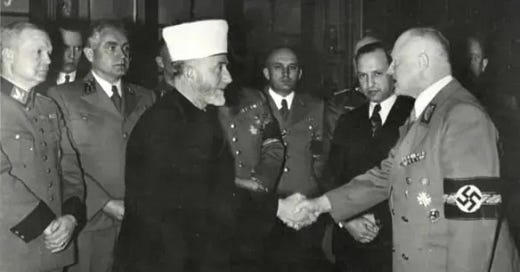






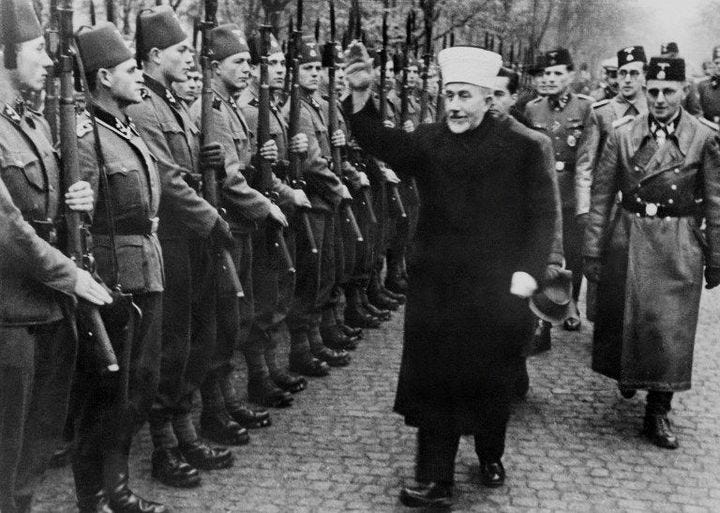
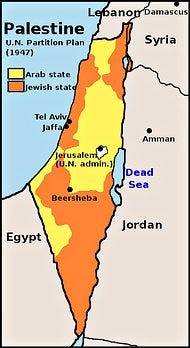


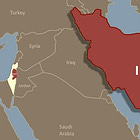
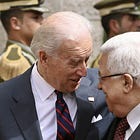
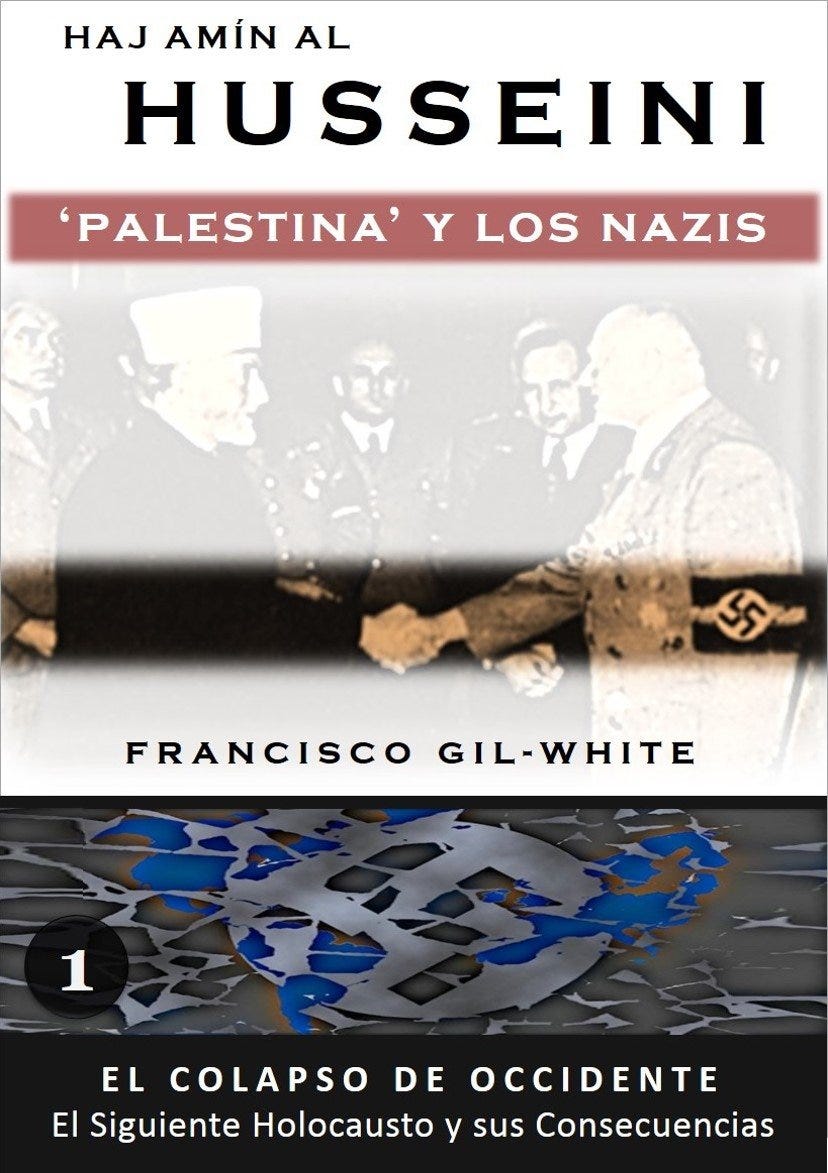
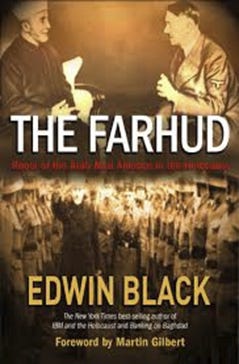
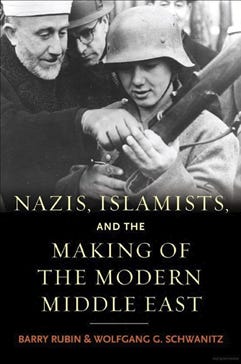


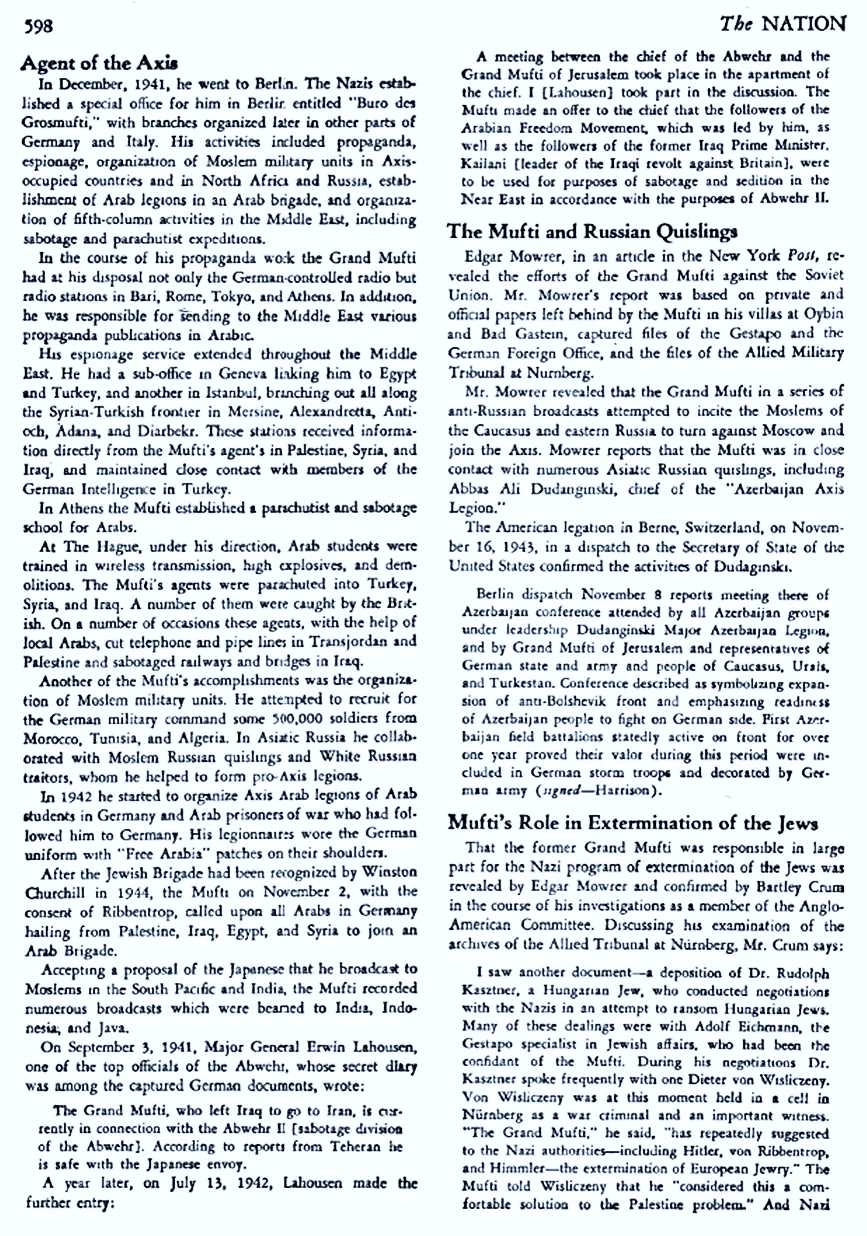
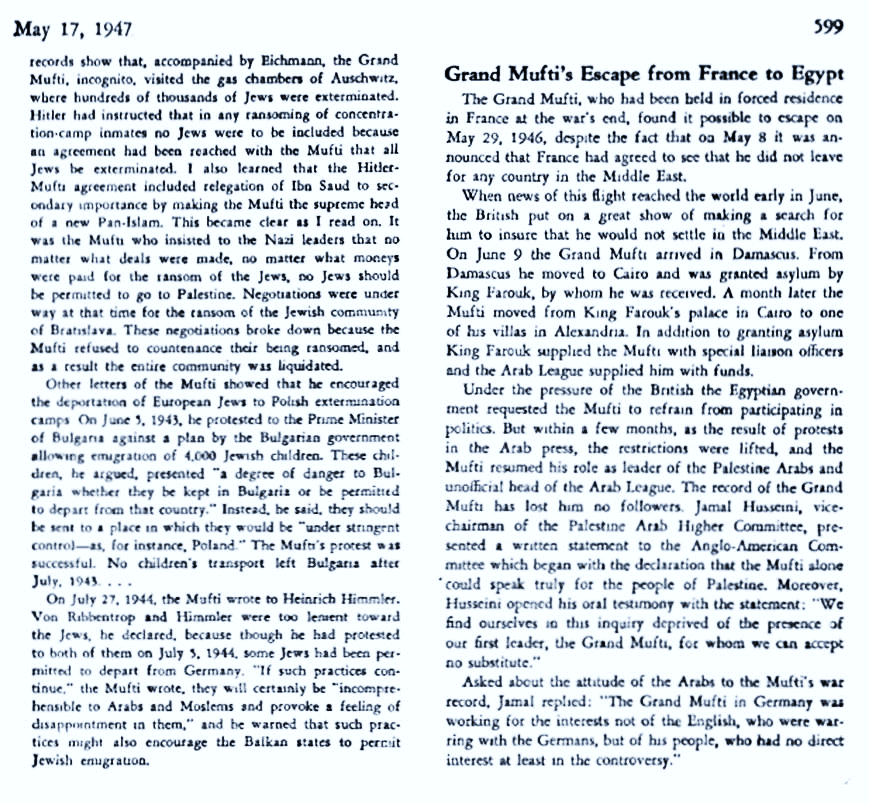


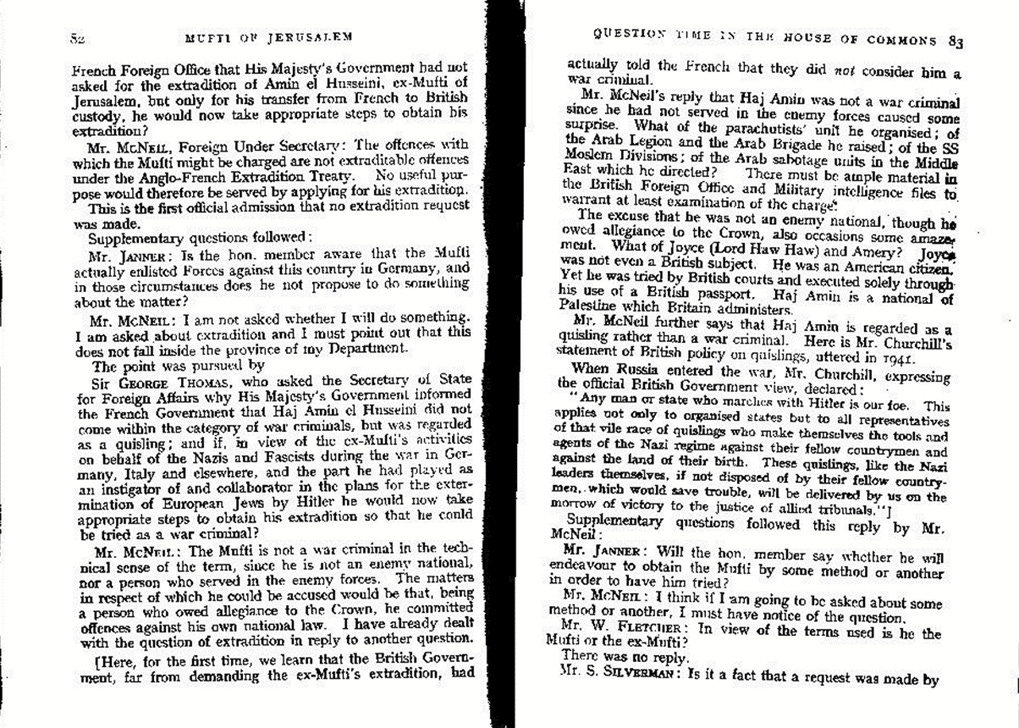
Better than ever, well done. Thank you.
Astonishing article.
I take note of a bio documentary of the Mossad that I watched in the last year, maybe on Netflix, in which a retired head of Mossad relayed to the interviewer that he had chosen not to assist the Shah's team in attempting to eliminate Khameni.
Clearly the head of the Mossad at that time had no knowledge of Fatah's involvement in bringing Khameni to Iran from France.
The Mossad might re-read Proverbs 16.18 "pride comes before a fall" as well as the IDF on a daily basis.